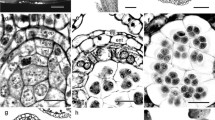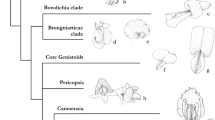Conclusions
There is no clearly defined disjunction betweenPetalostemon andDalea, and evidence from vegetative anatomy, floral morphology, and chromosome number indicates a common ancestry. Yet it is apparent thatPetalostemon represents a highly specialized branch within the heterogeneous daleoid complex. Such specialization has resulted in the loss of a whorl of stamens and migration of 4 petals to the apex of the staminal tube. The species ofDalea possessing petalostemoid characteristics appear to arise from diverse sections of the genus and probably represent specialized and independent, albeit somewhat convergent evolutionary trends. A complete reassessment of the placement ofPetalostemon must await revision of the remainder of the daleoid complex but it is desirable at present to redefine the generic delimitations ofPetalostemon to exclude all taxa possessing more than 5 stamens as well as those with petal insertion substantially below the apex of the staminal tube.
The reticulate, often convergent pathways taken by the evolutionary processes in many groups often makes generic lines somewhat indistinct. This is certainly true in many groups of legumes and emphatically true in other plant families (e.g. Cruciferae, Graminae). Therefore, at least more than one viewpoint of what constitutes generic delimitation in a particular taxon is admissible. The alternative to the present disposition ofPetalostemon, as advocated by Shinners (1949) and more recently by Barneby (1965), would be to reduce it to some subgeneric ranking withinDalea; but again, the same problems would be encountered only at a different taxonomic level. The acceptance ofPetalostemon as herein defined seems to result in a reasonably natural genus of perennials, easily definable from the diverse genusDalea.
Similar content being viewed by others
Literature Cited
Atchison, Earlene. 1949. Studies in the Leguminosae.IV. Chromosome numbers and geographical relationships of miscellaneous Leguminosae. Jour. Elisha Mitchell Soc.65: 118–122.
Barneby, R. C. 1965. Conservation and typification ofDalea. Taxon5: 160–164.
Brady, E. R., Wemple, D. K., &Lersten, N. R. 1964. Floral vasculature as a potential taxonomic character inDalea (Leguminosae). Iowa Acad. Jour. Sci.71: 46–51.
Gleason, H. A. 1952. Fabaceae. In Ill. Fl.2: 387–453.
Isely, D. 1958. Leguminosae: Psoraleae of the United States. A generic summary. Iowa St. Coll. Jour. Sci.33:23–36.
—. 1962. Leguminosae of the north-central states. IV. Psoraleae. Iowa St. Jour. Sci.37: 103–162.
Ledingham, G. F. 1957. Chromosome numbers of some Saskatchewan Leguminosae with particular reference toAstragalus andOxytropis. Canad. Jour. Bot.35: 657–666.
Michaux, A. 1803. Flora Boreali-Americana2: 48–50.
Moore, J. A. 1936. The vascular anatomy of the flower in the papilionaceous Leguminosae I. Am. Jour. Bot.23: 279–290.
Pfeiffer, H. 1928. Die pflanzlichen Trennungsgewebe. In Linsbauer, K., Hand. Pflanzenanat.5: (22).
Porter, C. L. 1957. Leguminosae of Nevada, III. Contrib. Fl. Nev.42: 1–69.
Raven, P. H., Kyhos, D. W., &Hill, A. J. 1965. Chromosome numbers of spermatophytes, mostly Californian. Aliso6: 105–113.
Rydberg, P. A. 1919–1920. Fabaceae: Psoraleae. N. Am. Fl.24: 1–136.
Sass, J. E. 1958. Botanical Microtechnique. 3rd ed. xi + 22S pp. Iowa St. Univ. Press, Ames.
Sharsmith, H. K. 1961. The genusHesperolinon (Linaceae). Univ. Calif. Publ. Bot.32: 235–314.
Stunners, L. H. 1949. Transfer of Texas species ofPetalostemon toDalea (Leguminosae). Field Lab.17: 81–85.
Turner, B. L. 1956. Chromosome numbers in the Leguminosae. I. Am. Jour. Bot.43: 577–581
—. 1959. The legumes of Texas. Univ. Texas Press, Austin. 284 p.
—. 1963.In Documented Chromosome Numbers of Plants. Madrono17: 116.
— 1960. Chromosome numbers in the Leguminosae. III. Species of the southwestern United States and Mexico. Am. Jour. Bot.47: 603–608.
Wiggins, I. L. 1940. Taxonomic notes on the genusDalea Juss. and related genera as represented in the Sonoran Desert. Contr. Dudley Herb.3: 41–55.
Author information
Authors and Affiliations
Additional information
Journal Paper No. J-5049 of the Iowa Agricultural Experiment Station. Project No. 1073.
These studies were initiated while the senior author was a National Science Foundation Graduate Fellow.
Rights and permissions
About this article
Cite this article
Wemple, D.K., Lersten, N.R. An interpretation of the flower of petalostemon (leguminosae). Brittonia 18, 117–126 (1966). https://doi.org/10.2307/2805193
Published:
Issue Date:
DOI: https://doi.org/10.2307/2805193




